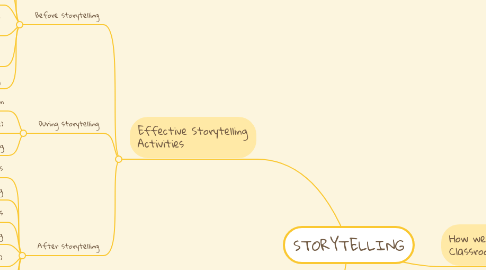
1. Effective Storytelling Activities
1.1. Before storytelling
1.1.1. capture their attention
1.1.2. Connect prior knowledge and experience
1.1.3. Review language students have learned
1.1.4. Ptre-teach new vocabulary or expressions
1.1.5. Ask students to predict what will happen in the story
1.1.6. Give students purpose fro listening
1.2. During storytelling
1.2.1. Repetition
1.2.2. TPR(total Physical Response)
1.2.3. Create tour own ending
1.3. After storytelling
1.3.1. Check predictions
1.3.2. Group retelling
1.3.3. Games
1.3.4. Storyboarding
1.3.5. Story mapping(story analysis)
1.3.6. Mini- books
1.3.7. Personalized or parallel story
1.3.8. Projects
2. How we tell Stories in the Classroom
2.1. Choose the right story
2.1.1. Be highly predictable
2.1.2. Be familiar to the home culture
2.1.3. Have a high percentage of known vocabulary
2.1.4. Include repetitive and predictable patterns
2.1.5. Provide opportunities to apply drama and Total Physical Response
2.1.6. lend themselves well to use of visuals and realia to make input comprehensible
2.2. Prepare to Tell a Story
2.2.1. Theatrics
2.2.1.1. Gestures
2.2.1.2. Body movement
2.2.1.3. Dramatic pauses
2.2.1.4. Character voices
2.2.1.5. Facial expressions
2.2.1.6. Speaking slowly and clearly
2.2.2. Props
2.2.2.1. Visuals for setting and characters
2.2.2.2. Realia
2.2.2.3. Masks for role play
2.2.2.4. Costumes for role play
2.2.2.5. Hand or finger puppets
2.2.2.6. PowerPoint slides or storyboards
2.2.3. Rehearsals
2.2.3.1. Memorize the text, including questions for students
2.2.3.2. Use cue cards if necessary
2.2.3.3. Practice in front of the mirror
2.2.3.4. Record/videotape yourself
2.2.3.5. Rehearse using props
2.2.3.6. A lot of practice
2.2.4. Script
2.2.4.1. Use illustrations from the storybook
2.2.4.2. Adapt the script to learners’ levels
2.2.4.3. Create roles students can play
2.2.4.4. Integrate songs or chants
2.2.4.5. Prepare places in the storytelling
2.2.4.6. for questions and predictions
3. Why we tell stories in the classroom
3.1. It is an authentic form of communication.
3.1.1. Storytelling is part of every culture
3.1.2. A tradition used to communicate culture from one generationto the next
3.2. It introduces new cultures to children.
3.2.1. Stories are full of culture, children are exposed to the values of various cultures
3.3. It teaches young learners in an entertaining way.
3.3.1. Stories can capture the interest and imagination of children
3.3.2. Young learners acquire language unconsciously
3.4. It helps develop critical thinking skills.
3.4.1. Asking questions that require students to analyze and make inferences,
3.4.2. Encouraging students to compare themselves and their cultures to the stories they have heard.
